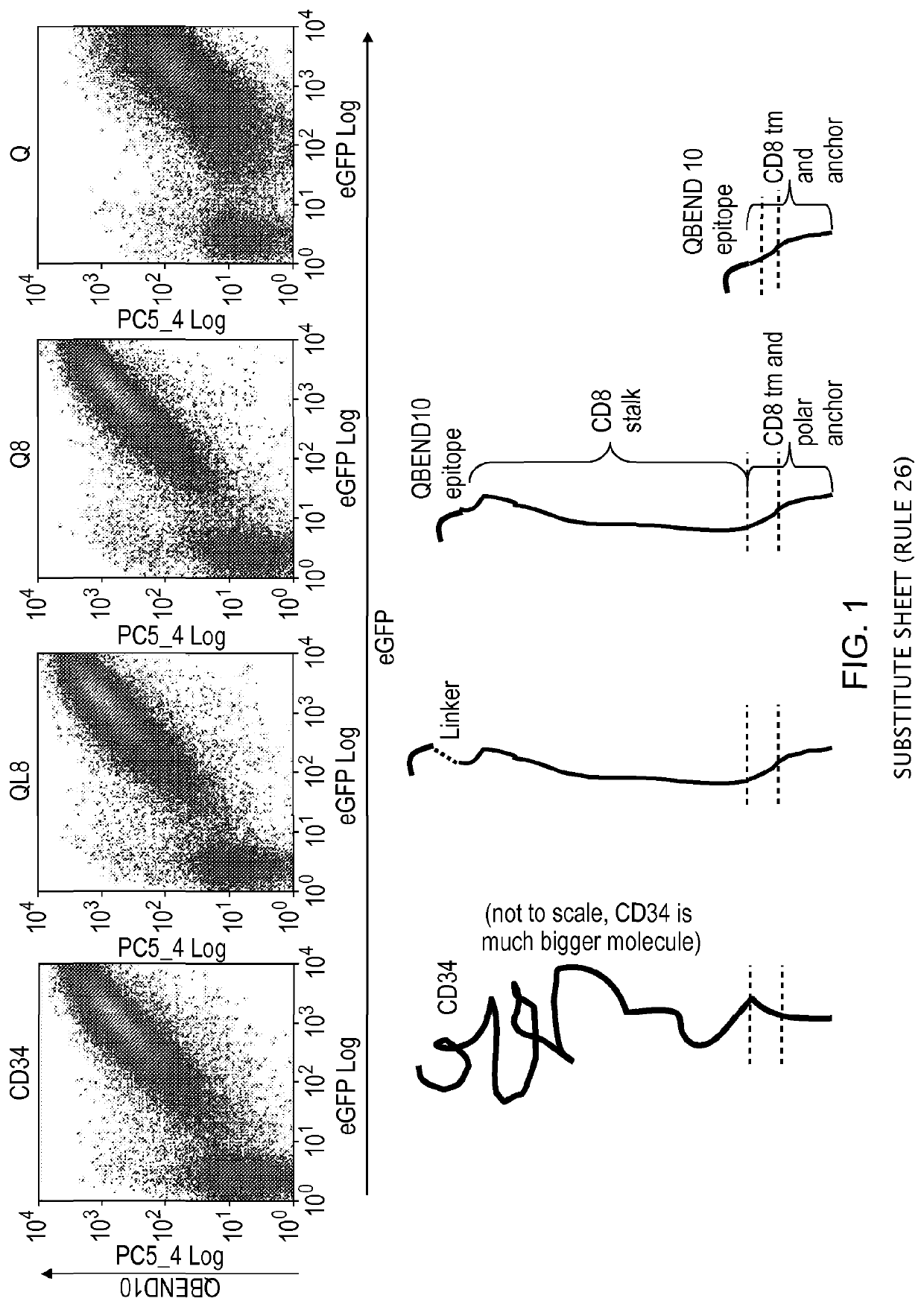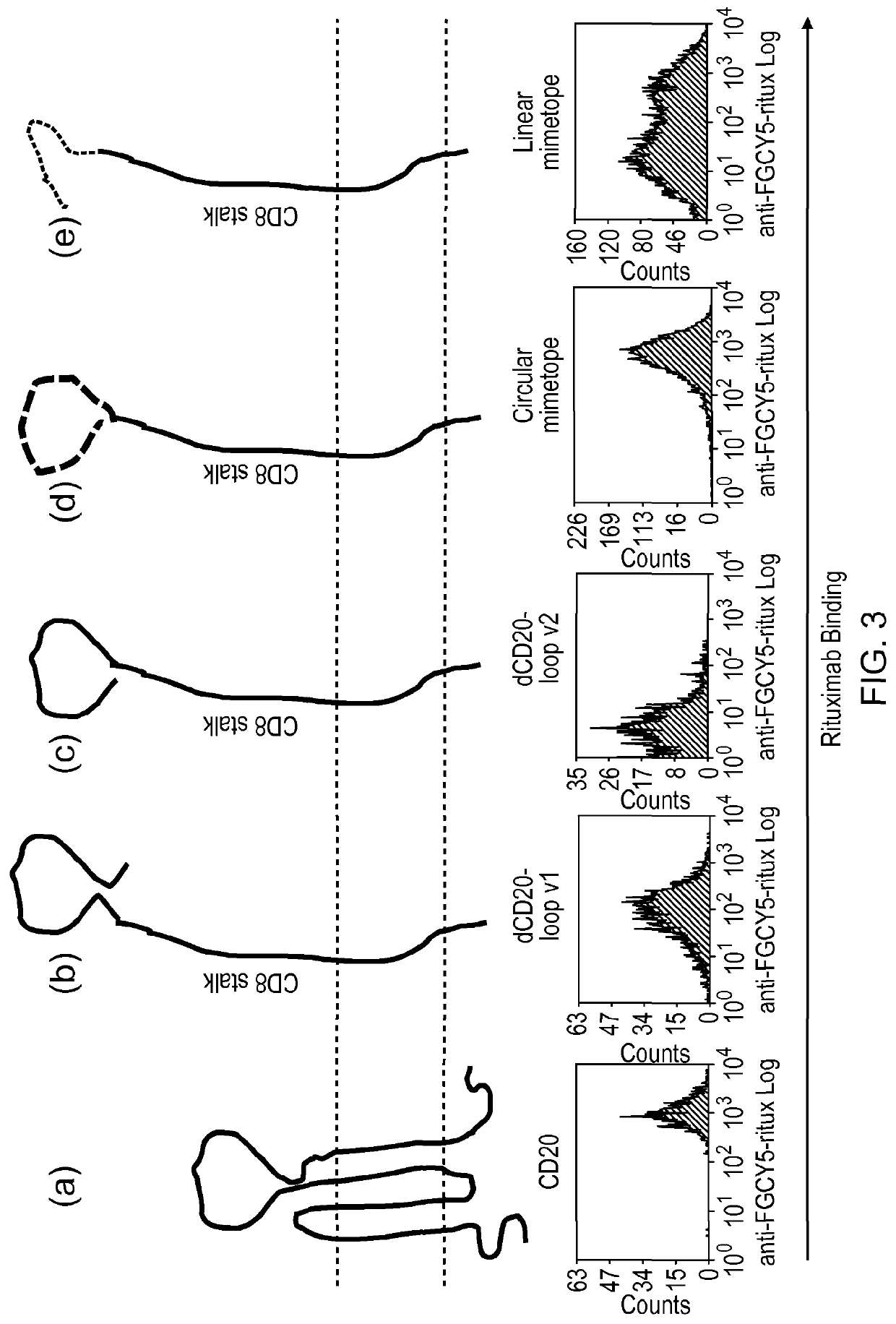Marker-suicide gene useful in adoptive cell therapy
a technology of adoptive cell therapy and spleen, which is applied in the direction of immunoglobulins, peptides, drug compositions against animals/humans, etc., can solve the problems of inability to detect and treat spleen cancer, risk of vector insertional mutagenesis always present, and associated adverse events, etc., to avoid biological effects and facilitate packaging
- Summary
- Abstract
- Description
- Claims
- Application Information
AI Technical Summary
Benefits of technology
Problems solved by technology
Method used
Image
Examples
example 1
Epitope Mapping the QBEnd10 Epitope from the CD34 Antigen
[0187]The present inventors first sought to find the epitope of CD34 which binds QBEND10, the antibody used in Miltenyi CliniMACS CD34 selection system. To this end, they generated a retroviral library of putative QBEnd10 binding epitopes from the native CD34 antigen.
[0188]Having isolated a QBEnd10 binding domain, further minimisation of the QBEnd10 binding epitope was achieved using a bi-directional deletion strategy (FIG. 11).
[0189]A final minimal epitope binding construct was derived containing only 16 amino acid residues and having the sequence ELPTQGTFSNVSTNVS.
example 2
Introducing a Spacer to Distance the CD34 Epitope from the Cell Surface
[0190]Various stalk and linker combinations were tested in order to investigate improvements in presentation of the epitope. To test the binding efficacy of the marker-gene, a bicistronic vector was used expressing eGFP as a marker of successful transfection.
[0191]The stalk used was derived from CD8alpha. This highly glycosylated structure acts as an effective spacer, elevating the epitope from the cell surface. It is relatively short in length: only 49 amino acids long.
[0192]Three constructs were considered: two CD8 stalk-bound constructs, with and without a flexible linker sequence, to project the putative epitope away from the cell surface, compared against a smaller membrane-proximal construct. The CD8 stalk-bound construct could achieve equal binding of QBEND10 as for full-length CD34 (FIG. 1). T-cells transduced with this construct were shown to be readily magnetically sorted using Miltenyi QBEnd10 beads (F...
example 3
Inclusion of a Rituximab-Binding Epitope
[0193]The present inventors decided to epitope map the CD20 B-cell antigen as a putative suicide gene. Rituximab is highly lytic for CD20 expressing targets. Recent crystallographic data has identified the Rituximab-binding interaction as being localised to the large extracellular loop. Based on this data, the present inventors generated a pair of constructs expressing versions of this minimal loop structure.
[0194]They first co-expressed different fragments of the CD20 major extracellular loop identified by crystallography to be the Rituximab binding site. These constructs failed to bind Rituximab.
[0195]Next, they tried linear and circular Rituximab-binding mimetopes (described by Perosa et al (2006) as above). Mimetopes are peptide sequences identified by phage display, which demonstrate good binding of a target antibody. They selected both a circular mimetope, constrained by disulphide bonds, and a linear mimetope for consideration (FIG. 12)...
PUM
| Property | Measurement | Unit |
|---|---|---|
| length | aaaaa | aaaaa |
| distance | aaaaa | aaaaa |
| nucleic acid sequence | aaaaa | aaaaa |
Abstract
Description
Claims
Application Information
 Login to View More
Login to View More - R&D
- Intellectual Property
- Life Sciences
- Materials
- Tech Scout
- Unparalleled Data Quality
- Higher Quality Content
- 60% Fewer Hallucinations
Browse by: Latest US Patents, China's latest patents, Technical Efficacy Thesaurus, Application Domain, Technology Topic, Popular Technical Reports.
© 2025 PatSnap. All rights reserved.Legal|Privacy policy|Modern Slavery Act Transparency Statement|Sitemap|About US| Contact US: help@patsnap.com



